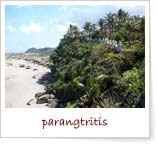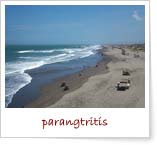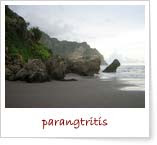
The
naming of the beach has its own history. Hundreds years ago, someone
named Dipokusumo, who was a fugitive of Majapahit Kingdom, came to this
area to meditate. When he saw water dripping from the crack of the
coral reef, he named this area 'parangtritis', originating from the
word parang (stone) and tumaritis (water drops). The beach close to the
area was then named the same.
Parangtritis is a beach full of myths,
which is believed to be the manifestation of the unity among Merapi
Mountain, Yogyakarta Kingdom, and Parangtritis Beach. The legend tells
that Panembahan Senopati and Sunan Kalijaga once met in this place
after completing their meditation. Panembahan Senopati was reminded of
being a humble ruler despite his supernatural powers.
The primary
attraction of this beach is its natural view. The enchantment of the
coastal scenery can be seen from different angles to give you different
experiences. When you are standing at the seashore, you will see the
wide ocean with the high waves and steeply mountainside on the east
side.

To
get the view from the site, just walk or hire the horse-cart westwards
and you look southwards when you have reached the place. You may get to
the place by riding a horse that you shall rent at negotiable price.
After
enjoying the scenery of Parangtritis beach from the seashore, you can
leave for Langse Cave for a different experience. On the earth road
leading to the cave, you can look westwards to see Parangtritis from
different angle. The high waves rushing to the shore will look silvery
under the sun, and will look golden by the sunset time. YogYES got the
opportunity to see this exotic view during its visit a couple of days
ago.
Before reaching Langse Cave, we suggest that you pay a visit to
the graveyard of Syeh Bela Belu that will give you spiritual
experience. Usually, many pilgrims come on certain days such as certain
Tuesday that is called Kliwon on Javanese calendar as one of the five
Javanese days of the week.

From
the graveyard, you may challenge yourself to continue your journey to
Langse Cave that you have to go on foot to get to the cave that is 3
kilometers away through as high as 400 meters mountainside at the slope
of almost 900. To get into the cave that is also called the Queen of
South cave, you have to get the permission from the tomb guard.
According to the guard of Depok Beach several times entered the cave
when he was young, we will get beautiful view of the south ocean at the
mouth of the cave that directly faces the ocean.
On the fifth day of
the fifth month of Chinese calendar, you will be able to see Peh Cun
ceremony procession in Parangtritis. Peh Cun, originating from the word
Peh that means oar and Cun that means boat, is Chinese expression of
gratitude to God. This rite is also meant to commemorate Khut Gwan (Qi
Yuan), a loyal patriot as well as a minister who was once betrayed by
his colleague so that he committed a suicide.

Peh
Cun ceremony is unique since there is no festival of dragon-decorated
boats rowing like in other regions, instead there is an attraction of
standing egg. The attraction begin at 11:00 a.m. and by afternoon,
according to the myth, the egg will stand upright with no means of
support are needed. By 01:00 p.m., however, the egg will suddenly fall
down and no one can erect it anymore.
To get to Parangtritis Beach,
you can take either one of the two routes. One is the route of
Yogyakarta-Imogiri-Siluk-Parangtritis with the river and coral reel
scenery on the way. The other is Yogyakarta-Parangtritis route that is
easier to take with quite smooth road. It is suggested that you do not
wear green clothes to respect local people who believe that green
clothes will bring misfortune.





